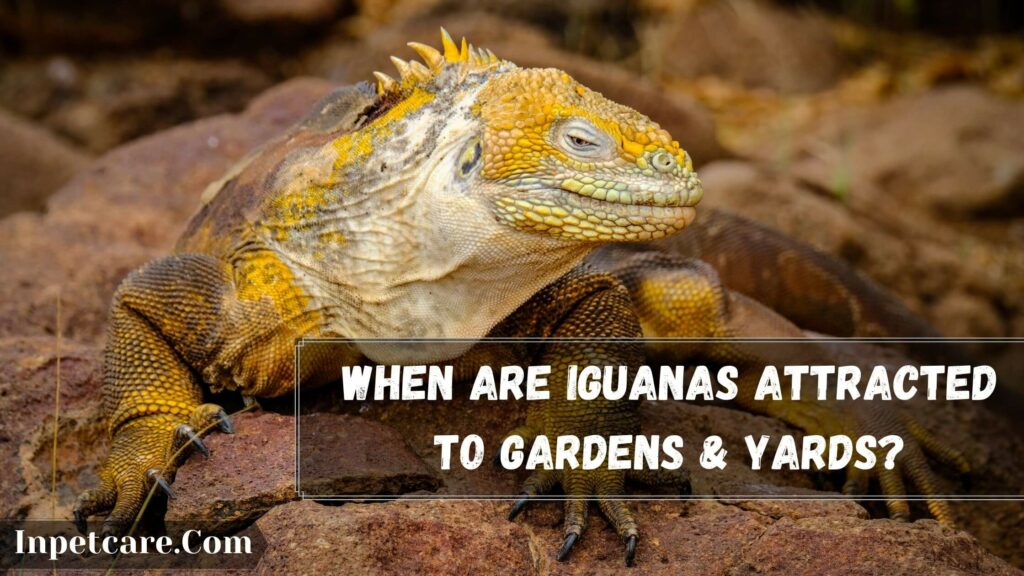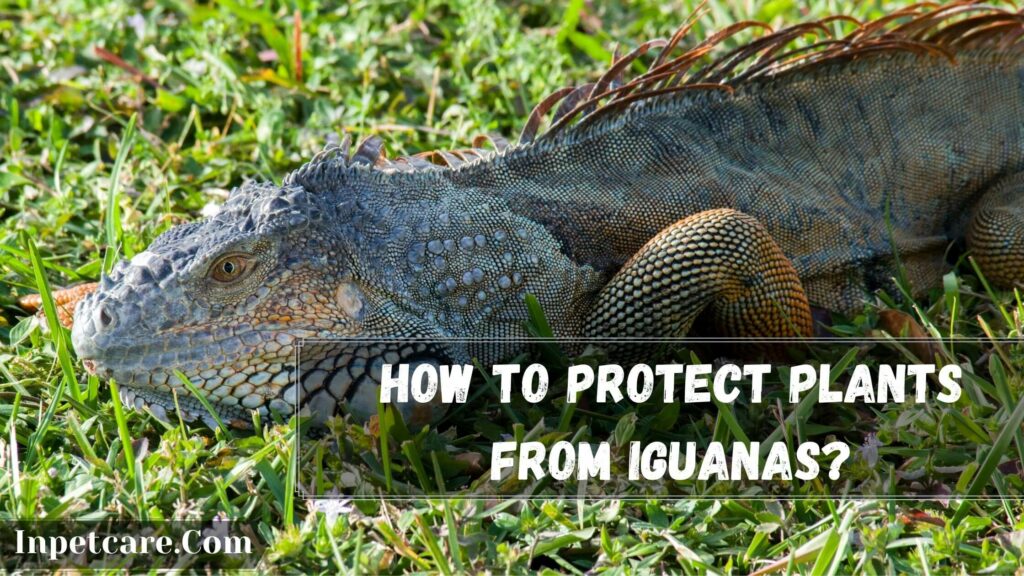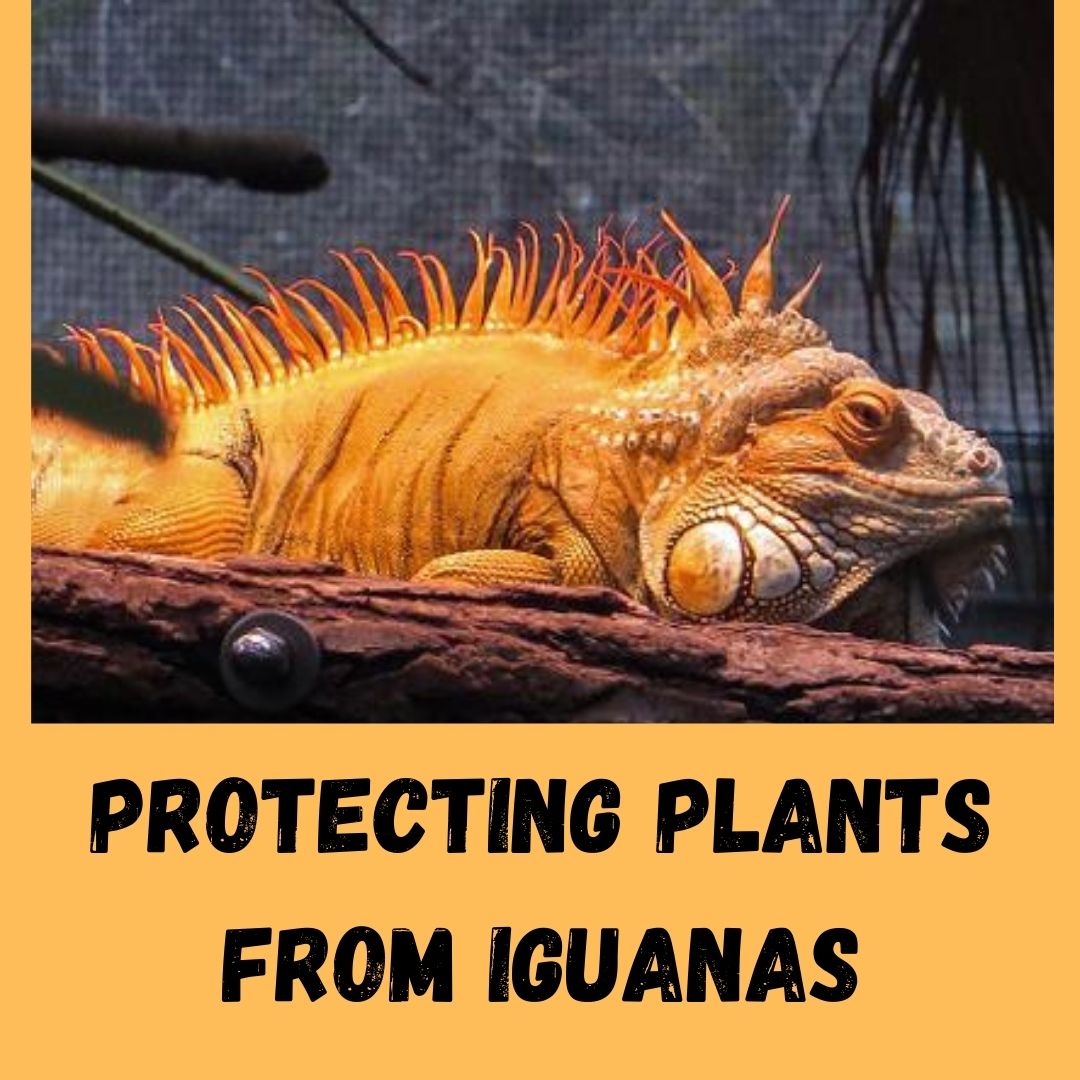Being herbivorous, iguanas prey on plant matter. It is common to see iguanas feeding on vegetables, shrubs and crops. If Iguana is destroying your plants, you may be looking for ways to save them. In this article, I will help you learn how to protect plants from iguanas.
They particularly like flowering shrubs like hibiscus, including some fruits and vegetables. Iguanas tend to dig burrows resulting in your lawn is damaged also. They also leave poops that can be unsightly and smelly and can be a health hazard as it contains salmonella. Iguana facesContain salmonella. Let’s first learn when iguanas are attracted to yards and gardens.
Post Contents
When are Iguanas Attracted To Gardens & Yards?

Leftovers
In the southern part of Florida, iguanas are widely distributed due to an increasing population. It is also known as a pest and is legal to hunt down in Florida. Therefore if you have a large party in your backyard, never leave the uneaten food unattended. Discard the leftovers or store them somewhere else when the parties are over. To Iguanas, It will send a message that they are not invited.
Other Plants
Do you know that fruits and vegetables are not the only treats iguanas feed on? Other plants and their matter can also entice Iguana. Iguanas enjoy eating fruits and leaves of most flowering shrubs and protecting your flowers from these destructive herbivorous lizards, either with cages or wire netting.
You can also consider planting some species that iguanas don’t eat. Plants like crotons and oleanders are not at all lure iguanas.
Pet Food
Another thing that can attract an Iguana to your property is pet food. If there is any pet food unintentionally left somewhere, giving easy access to your Iguana, they will come to eat it. So, the solution here is straightforward. You should avoid feeding your pets outside.
Sometimes, we often need to monitor our families, friends, or neighbourhood pet, and in that case, you cannot bring the food bowls inside as it’s not an ideal option. So, I recommend you constantly monitor the food dish while the pet is eating. It would help if you considered removing the word as soon as they are done.
Garbage
Being predominantly herbivorous, garbage seems the most attractive place for Iguana to find food. As waste is easy to access, iguanas will often catch edible smells. Besides pet food, if your household presents lots of discarded vegetables or any food source, a green Iguana may look to inhibit.
It is essential always to put the garbage in a secure trash container. Do you know that trash bags are no deterrent to Iguanas? Most of the trash with loose leads offers little protection. I would recommend you invest in an animal-proof trash can with a secure lid to make it Iguana proof. You can also use a cinder block to keep the top on and iguanas out.
Fruit Trees
Iguanas love fruits and vegetables. If there is any fruit or low hanging fruit in your backyard, it can invite many plants and fruit-eating lizards. Fruits like mango and avocado are tasty snacks to Iguana with minimal effort.
Adding to this, fruits that have fallen to the ground are also a better and easy option for Iguanas to have. It is necessary to close up the shop if the Iguanas have been feeding on your fruit trees. If there is any fallen fruit in your yard, look to discard it in a secure container.
To enjoy the outcome of the fruit trees, I would recommend you always gather any low hanging fruit for your family before it gets eaten by lizards. If you are looking for a long term solution, you should plant some citrus trees in your yard that can deter Iguanas. Let’s talk about how to protect plants from iguanas.
How To Protect Plants From Iguanas?

Most of the iguanas found in your backyard were either domesticated and escaped or were released by the owners who no longer wanted to take care of them. Therefore it doesn’t mean that you should go and pick that Iguana, as it can carry many health hazards.
You should avoid touching any Iguana. Most formal pets that have gone feral usually have dangerous and contaminated health. Iguanas can bite and quickly go through human skin. Therefore you should always avoid touching or picking them as it can be hazardous if they are threatened. Let’s talk about seven ways to plant Iguana.
7 Ways To Protect Plants From Iguanas
Avoid Feeding Them
Stop leaving any food if you are not intentionally feeding your Iguana. Avoid feeding any Iguana found in your yard; otherwise, those lizards will always come to look for a feast.
Tree Wrap
Iguanas are arboreal and natural tree climbers. Natural tree trunks make a prime nesting spot for these plant-eating lizards. Adding to this, iguanas often enjoy lying on the upper branches of trees to enjoy basking. As a responsible homeowner, it is essential to cut off easy access to these iguanas.
You can either work with an expert like an Iguana control agency or install a tree wrap to prevent the lizards from climbing. You should also take the help of experts to install a high-quality trap that is effective enough in keeping Iguana from climbing.
Interesting Further Reading
Yard Maintenance
Apart from the food, iguanas also need housing. For Iguana’s basic needs, they will look for landscapes on your property to dig a hole. You should always have essential yard maintenance and landscaping features to keep Iguanas inhibiting your property. Without proper maintenance of your yard, your property can become an Iguana oasis.
Trimming
If there are any flowering shrubs, then make sure to trim shrubs. Flowering shrubs and fruit trees often lure iguanas. If there is any tree near your home that serves as a bridge for Iguana to reach your home roof and allow them to enter your household, then make sure to trim it.
Once an Iguana is inside your home, it can start digging, resulting in leaks and leaving unsanitary droppings that contain harmful salmonella. It is always best to trim out overgrown trees and shrubs where Iguana can hide. An Iguana pest control agency can help you identify and trom thorny branches that give easy access to iguanas.
Install Iguana Barriers
You can also consider installing barriers along your property lines or filling through the Iguana’s hole. It is always best to guard the parameter of the property. Whether it’s meant to instil an Iguana proof fence around your yard or call an iguana control to have a seawall barrier, both are 100% effective in keeping iguanas from crawling into your home.
If you reside near waterways and docks, a wall barrier is what you should go with. If there is a dock near your home, consider having dock piling wrap just like tree wrap to prevent iguanas from using any wood fillings or cement to enter your backyard.
Fill Holes
It is essential to look for any holes that Iguana has dug. They are not only excellent climbers, but they are also experts in searching. They are known to excavate long tunnels that give easy access to your property. Iguana also digests for nesting.
It is best to fill those whole and install additional barriers near them to prevent their return. Filling those holes will send a clear message to Iguanas that they will never find their Oasis in your yard. Always look for spots during the daytime when they will bask in the sun or forage for food.
Make sure you are not filling those holes with diet, as it can easily dig again through it to return to its caves. It is best to fill those holes by dropping some large rocks. Rocks will add an extra layer of protection. Again the best solution is Iguana control the anti hole barrier.
Anti hole barrier will provide an extra layer of protection from dirt. With an anti hole barrier, you can prevent the iguanas from entering its bureau. Many Iguana agencies also provide services of exceptional vigilance against the appearance of new caves and Iguanas.
Extermination
More than 90% of the service from Iguana control agencies effectively keeps the Iguana from entering your yard or home. Most agencies that control iguanas are well equipped with devices and the necessary equipment to handle the most stubborn pests. They will help you remove as many as Iguana in the last resort. Let’s take a look at some tips to protect plants from iguanas.
5 Tips To Protect Plants From Iguanas
- It is best to make your garden more friendly to predators prey on iguanas. Planting some trees that attract Birds like crows and owls will keep the Iguana out of your yard. Birds will eat young ones.
- Avoid leaving any leftover or uneaten food or its scraps. Vegetables in open compost bins or out in the garden can invite iguanas. In a word, you should avoid giving easy access to additional food sources to these lizards.
- Always get rid of flowering shrubs or low-growing plants in one hour if it is inviting more in 1 hour. Low growth plants hanging, fruits, flowering shrubs, and piles of branches entice Iguana to come. Adding to this, you should also get rid of warm surfaces like rocks and sidewalks.
- Always fill the burrow as you find them and never leave it unattended. You should avoid keeping the holes open. It is best to look for gaps and caves during the days when the Iguana will not be in there.
- You should install low fences around your yard to keep Iguana from entering. Even low walls around your garden will be effective in keeping iguanas out. In addition, on shrubs and trees, slick metal collars of 6-10 inches can also be placed around the plant trunk or tree trunk to keep these plant-eating lizards from eating or climbing the fruit trees or flower shrubs.
Conclusion
I hope I have tried my best to give you all the information about how to save plants from Iguanas. All these methods are well tested and performed by many owners who have had success in keeping Iguana from entering their yards or home.
I hope all this information on how to save plants from Iguanas will guide you in keeping those plant-eating lizards out of your property. Share this article with others to make them aware of what these lizards can do and how much damage they can cause.
If you like this article, check our other post on Iguana. See you in the other piece, till then, take care and goodbye.

94% of pet owners say their animal pal makes them smile more than once a day. In 2007, I realized that I was made for saving Animals. My father is a Vet, and I think every pet deserves one. I started this blog, “InPetCare”, in 2019 with my father to enlighten a wider audience.
